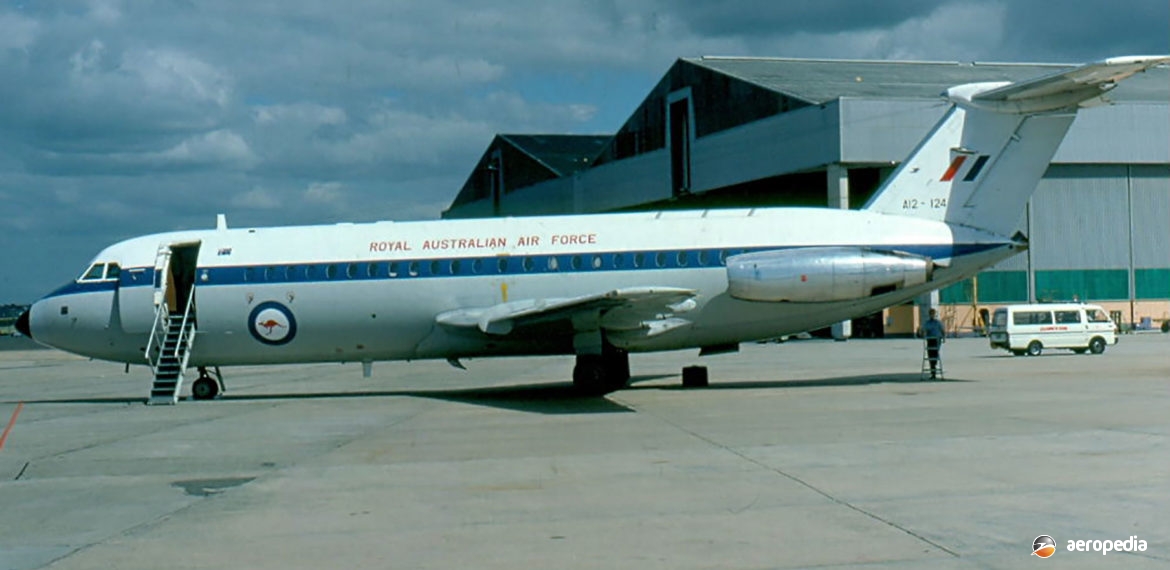Photograph:
RAAF BAC One Eleven Model 217EA A12-124 at Mascot, NSW (David C Eyre)
Country of origin:
United Kingdom
Description:
Medium-range commercial transport
Power Plant:
(Series 200)
Two 10,600 lbst Rolls Royce Spey RB163-2 turbojets
Specifications:
- Wingspan: 26.97 m (88 ft 6 in)
- Length: 28.5 m (93 ft 6 in)
- Height: 7.2 m (23 ft 6 in)
- Wing area: 91.04 m² (980 sq ft)
- Max cruising speed at 7,620 m (25,000 ft): 885 km/h (550 mph)
- Economical cruising speed: 816 km/h (507 mph)
- Range with 5,334 kg (11,760 lb) payload: 3,225 km (2,000 miles)
- Range with 6,234 kg (13,744 lb) payload: 2,844 km (1,767 miles)
- Empty weight: 20,061 kg (44,226 lb)
- Loaded weight: 33,793 kg (74,500 lb)
History:
The BAC One Eleven was designed as a turbojet successor to the Vickers Viscount series of airliners and, although it was not as successful in sales as that aircraft, some 220 odd were delivered in a variety of variants.
The One Eleven project commenced in 1960, being acquired by the British Aircraft Corporation, which itself was a merger of Vickers, Bristol, and English Electric. The project really got off the ground in May 1961 with an order for ten aircraft by British United Airways (BUA). The order book commenced to grow, the prototype G-ASHG (c/n 004) flying at Hurn in Dorset on 20 August 1963. However, this aircraft was lost on 22 October 1963 when a deep-stall problem occurred. Type Certification was received on 6 April 1965, and the type entered service with British United and Braniff Airways, an American airlines, during that month.
A number of variants were developed to meet customer requirements. Following the early success of the design, BAC adopted the designation Series 200 for the first production batch, the next model produced becoming the Series 300, this having up-rated Spey engines and a centre-section fuel tank, the gross weight increasing to 39,463 kg (87,000 lb). The next model was the Series 400, this being designed specifically for the American market, the Series 200, 300 and 400 being dimensionally similar.
On 30 June 1967 the prototype of the Series 500 flew, this being a modified Series 400 with Spey 512-14 engines of 12,000 lbst, and an increase in fuselage length by 4.11 m (13 ft 6 in). As soon as this model entered service it received up-rated Spey 512-14DW engines of 12,550 lbst, and the gross weight increased to 45,200 kg (99,650 lb).
The next variant to appear was the Series 475, the prototype flying on 27 August 1970, this being the Series 500 prototype converted back to a short fuselage and fitted with the Spey 512-14DW engines, the extra power of these engines with the lower weight of the short fuselage being ideal for operations in hot and high areas. It also had the extended wingspan of the Series 500, and low-pressure tyres for rough strips.
In January 1966 two BAC 111s (as they were also known) were ordered A12-124 (c/n 124 – call-sign VM-NLG) and A12-125 (c/n 125 – call sign VM-NLH) for the RAAF for VIP duties for the Australian Government and were delivered on 18 January and 8 February 1968 respectively. These machines were Series 200 (Model 217EA), were based at RAAF Fairbairn in the ACT and were operated by No 34 Squadron alongside three Mystere 20s and two HS.748s until replaced by Dassault Falcon 900s, thereafter being exported.
Three BAC 111s were operated in Fiji with Air Pacific, these being: BAC 111-413FA DQ-FBQ (c/n 245) from January 1971 to November 1975 when it was exported to the Royal Air Force as ZE433; BAC 111-475 DQ-FBV² (c/n 250) registered in July 1973 and exported to the RAF as ZE432; and BAC 111-413FA DQ-FCR (c/n 116) registered in April 1978, withdrawn from service in September 1981 and scrapped.
BAC-111-475 DQ-FBV², as noted, operated with Air Pacific in Fiji, and later went to the British Ministry of Defence as ZE432, saw service with the Empire Test Pilots School at Boscombe Down in Wiltshire, was scrapped in 2014, the forward fuselage being saved, restored and placed on display at the Bournemouth Aviation Museum.
In 1977 a deal was settled to build the BAC One Eleven in Romania, the intention being to manufacture 22 aircraft. The first aircraft was completed in August 1982 and nine aircraft were in fact delivered, mainly being operated by the Romanian carriers, Tarom and Romavia. In 1993 an order was received for 11 aircraft and five options for US carrier KIWI International Airlines. The first of these was to be delivered in 1995 but funding was not available and the program was halted.

